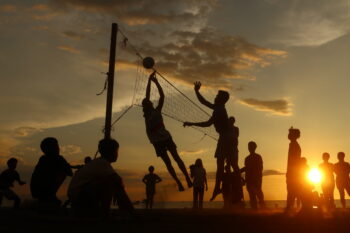MARAWI CITY (MindaNews / 26 April) — It is Ramadhan. That should have been an exclamation point as exciting an announcement as when my daughters and their cousins were grade schoolers and would gleefully shout “Piyagbangaaaan!” every time they hear the Maghrib call to prayer during Ramadhan.
They would shout at the top of their lungs as they rush to the kitchen as much as to break the news to us as if we could only hear of it from them as to start the sumptuous Iftar with the extended family. By family, it means including my parents, my siblings, their spouses and children, cousins, nieces, nephews and occasional visitors. Competition for the choice spot or comfortable chair is a constant happenstance among the kids.
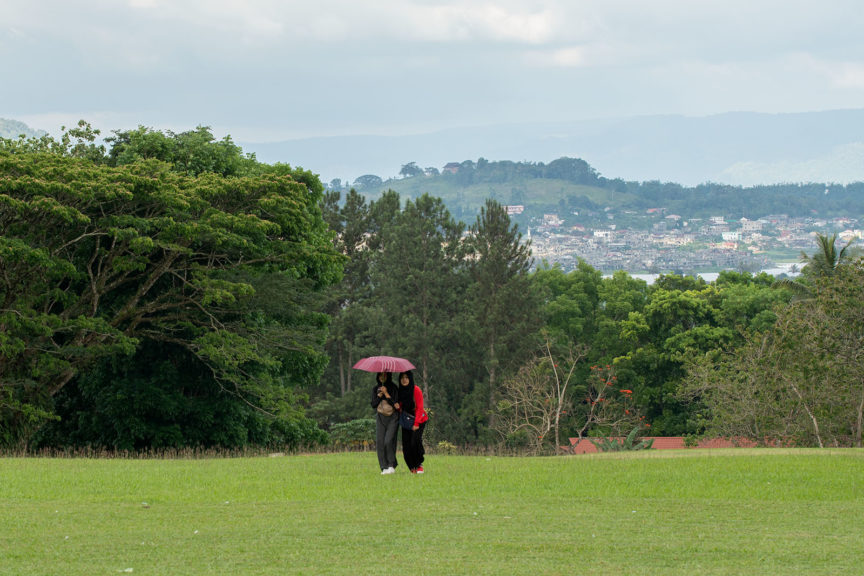 BEAUTY AMID THE RUINS. Meranaw students walk on the well manicured golf course of the Mindanao State University campus on Wednesday (29 May 2019) as Ground Zero in downtown Marawi in the far background lay in ruins. MindaNews photo by BOBBY TIMONERA
BEAUTY AMID THE RUINS. Meranaw students walk on the well manicured golf course of the Mindanao State University campus on Wednesday (29 May 2019) as Ground Zero in downtown Marawi in the far background lay in ruins. MindaNews photo by BOBBY TIMONERA
Ramadhan 2020/Ramadhan 1441 however came silently without fanfare to us Meranaws. As before, there would always be that pre-Ramadhan mad dash to Iligan City and Cagayan de Oro to purchase several months of food supply to be consumed in just a month. Today, people simply stayed at home or did their groceries at the nearby instant makeshift sidewalk market stalls which have sprouted from nowhere, scraping available supply to welcome the Holy Month of Ramadhan.
Ramadhan always meant family bonding, food, and the nightly troop to the masjid for Tarawih. Ramadhan was the only month we do have a nightlife. For the rest of the year, we are at home early and stay home after work.
Many moons ago when a couple of American friends visited me in Marawi, they were astounded to know our life sans nightlife. With no public transportation after office hours, no open restaurants, and no night events—there was rarely anything to do at night except stay at home, just like what is happening to us nowadays due to the Coronavirus. Except by “us” now, I mean almost the whole world.
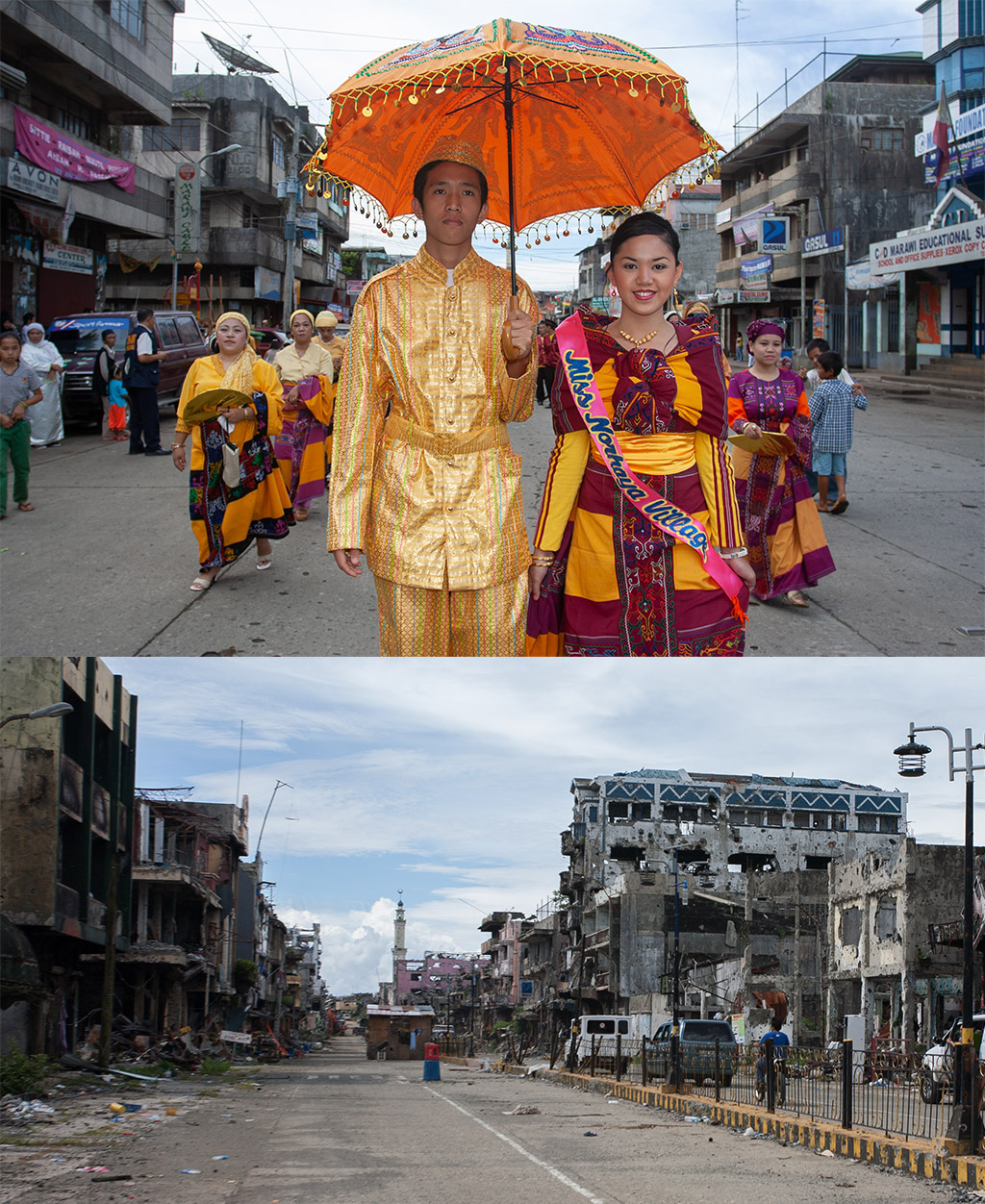 Gomisa Ave. (formerly Quezon Ave.) during a parade for Araw ng Marawi in 2009 and during Kambisita in May 2018. MindaNews photo by BOBBY TIMONERA
Gomisa Ave. (formerly Quezon Ave.) during a parade for Araw ng Marawi in 2009 and during Kambisita in May 2018. MindaNews photo by BOBBY TIMONERA
It was during the time of then Marawi City Mayor, the late Aleem Mahid Mutilan in the late 80s until the early 90s when Ramadan in Marawi City became a nightly public event. Although there had always been that night market in the former Plaza Cabili and the Barrio Paypay in Marawi City, Aleem Mutilan initiated the nightly Ramadan festivities such as Qur’an reading, Declamation, and Ramadan lights display competitions that converted the long stretch of the Quezon Avenue from the intersection going down to the City Jail and up to the Moncado Colony until the Banggolo area into a flowing jam-packed night market/community get-together.
I was in college at that time and the president of one student organization, the Zhakba—the New Generation. We participated in the festivities by selling Mom’s Pizza in front of the Mala a Walay (Big House) of my relatives the Dirampaten clan along Quezon Avenue fronting the Rizal Park and the Fire Department.
My aunties generously lent us their front yard and provided us with electricity also because it was an opportunity for them to meet relatives and friends at the same time. We did it for fun and to have a fixed place to hang-out and be part of something that was novel and unfolding.
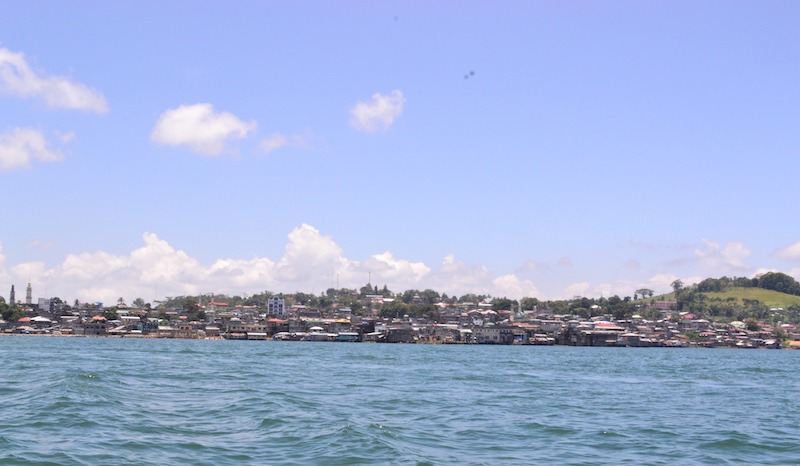 A view of downtown Marawi from the lake in 2011. Since 2017 this has become Ground Zero — the buildings reduced to rubble by the five-month war between government and Maute forces. Photo by Elin Anisha Guro
A view of downtown Marawi from the lake in 2011. Since 2017 this has become Ground Zero — the buildings reduced to rubble by the five-month war between government and Maute forces. Photo by Elin Anisha Guro
Earning a little despite sourcing our pizza boxes from a store at the Mindanao State University (MSU) campus was just a bonus. The traffic of people was more than enough for us to get a share of the market pie. Every night, masses of people from nearby provinces cramped in Ford Fieras—the women still wearing their moknas (prayer gowns)—would unload and amble by Quezon Avenue. Some young men and women from MSU and Tuca would simply walk towards the night market and back. Walking towards the city in groups was part of the fun. That was also the time that putting up of fairy lights known to us then only as “Christmas lights” to welcome the Holy Month of Ramadhan commenced. For the first time in my memory, our Ramadhan became festive and a public cultural event. Christian friends who saw the difference remarked: “Ah, lahi ra pud ang mga Muslim, kung mag-Christmas kay isa ka bulan!”
I recall that Tuca had the best display of fairy lights. It was exhilarating going around several barangays and see the display of lights. But for young Meranaw kids at that time, it was magical. Almost every house I know also put up “Christmas lights.”
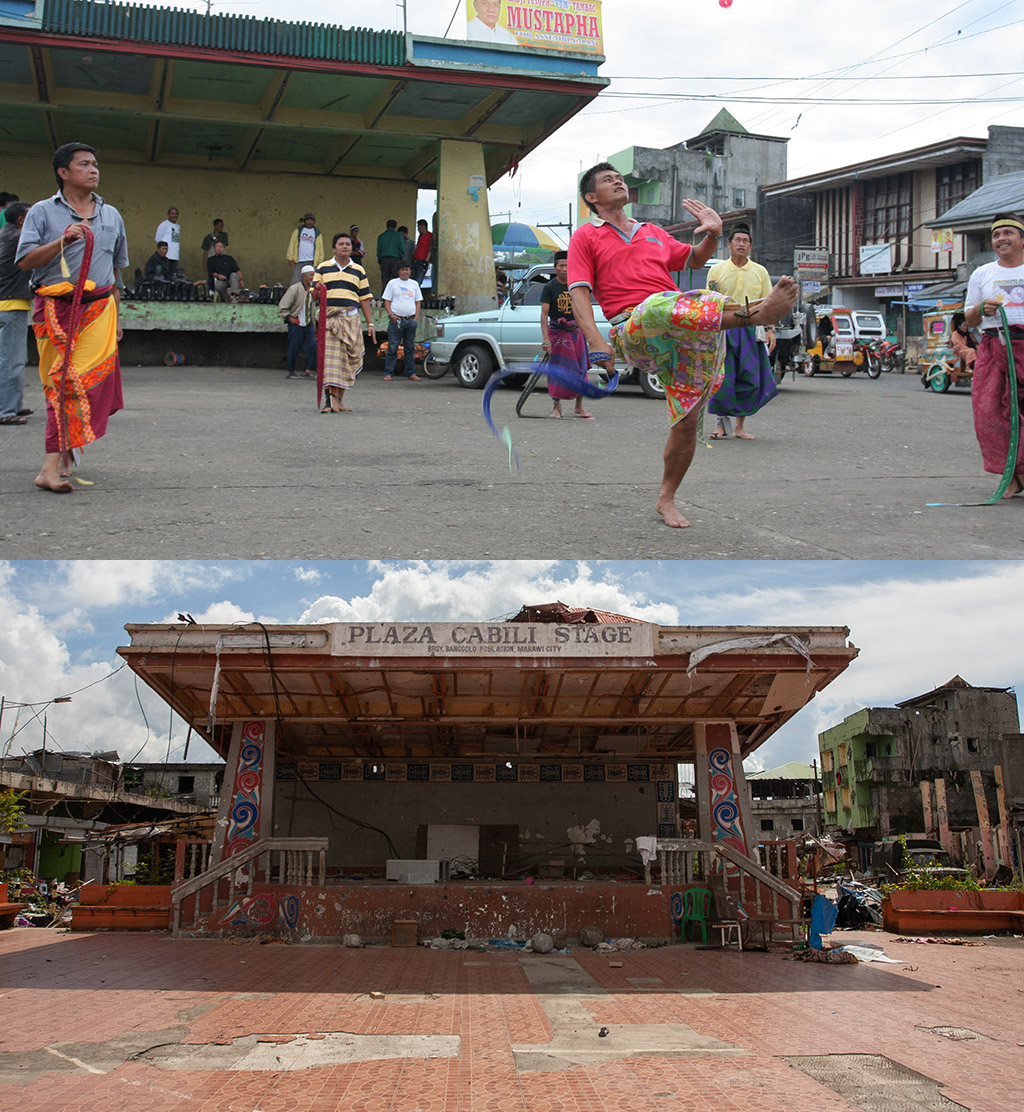 Plaza Cabili at Banggolo, in the heart of Marawi when Meranao men played kasipa sa manggis, photographed in 2008. The lower picture taken May 2018 during Kambisita, when residents were allowed to visit Ground Zero. MindaNews photo by BOBBY TIMONERA
Plaza Cabili at Banggolo, in the heart of Marawi when Meranao men played kasipa sa manggis, photographed in 2008. The lower picture taken May 2018 during Kambisita, when residents were allowed to visit Ground Zero. MindaNews photo by BOBBY TIMONERA
One poor old vendor mistakenly displayed actual Christmas lanterns for sale that he had to remove a few days after. Putting up Christmas lights was considered an allowable innovation but not lanterns, this would have been truly Christmasy because of the star design. At that time, those twinkling fairy lights came with Christmas songs. It was no wonder that we called them Christmas lights and were seen as solely a Christmas tradition indeed.
For a few years, we looked forward to the Holy Month of Ramadhan for the corresponding festivities too. Like anything that is new, the Ramadhan merriments had its own supporters and critics. Some ulama began criticizing it as, bid’ah or innovation and therefore haram and for its having enabled the “Barrio Takisa” where young men and women rendezvous instead of focusing on their prayers. Takisa comes from the Meranaw verb “takis” meaning to brush referring to the unavoidable rubbing of elbows due to the volume of people and its corresponding imputations, merited or not.
Putting up of “Christmas lights” was subsequently discouraged not only because it is emulating a “Christian tradition” but because it is extravagant and being showy. Not to mention the fact that Aleem Mutilan moved up the political rung. I think, it has also more to do with the name, rather than its being a Christian tradition, despite the fact that in some Muslim countries like Egypt and Malaysia, wrote my consul friend Gonaranao Musor, they do have lanterns and bazaars as well.
Ramadan is anything but drab and dreary there. They too, put up decorations, prepare Eid Cards, and yes install some Ramadhan lights as they would be referred to later. That new Ramadhan celebration lasted for several years only. Putting up of fairy lights fizzled out although the night market remained but wasn’t as attractive as before or perhaps people followed the advice of some ulama.
People around the world are facing this home quarantine brought by the COVID-19 virus differently. Understandably, we all find it difficult. Some willingly observe the quarantine believing in its wisdom to save lives including their own, others protest and defy it for myriad of reasons — some of them entirely stupid.
Still, there is that hope for them that after the quarantine, things can go back to normal in varying stages. But for us, there is no going back to those times. Not because some conservative ulama have spoken against it for surely other parallels and much more are found in Muslim countries, nor because of this home quarantine and the whole gamut of COVID-19 ramifications with no end in sight yet, but because our beloved Marawi City is gone.
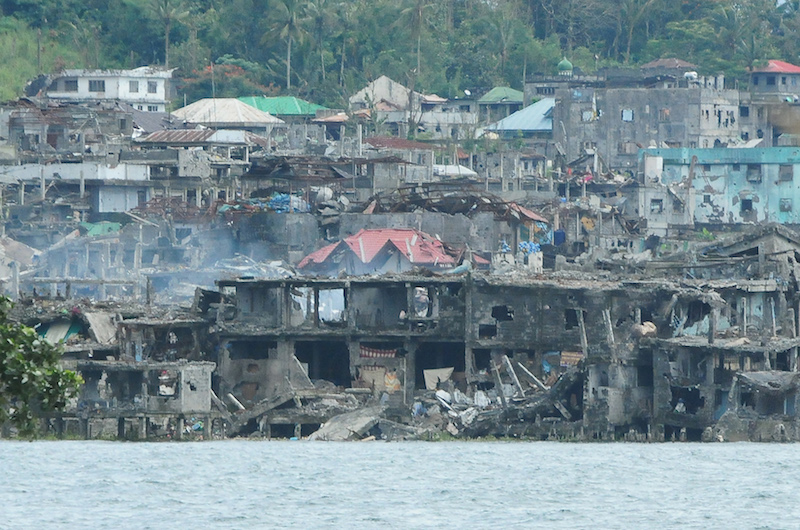 The view of what used to be the war zone in this photograph taken on October 26, 2017 from the other side of Lake Lanao: bombed-out buildings, houses and mosques, evident of the fierce fighting and relentless bombings against the Maute Group and its allies from May 23 to October 23, 2017. MindaNews photo by FROILAN GALLARDO
The view of what used to be the war zone in this photograph taken on October 26, 2017 from the other side of Lake Lanao: bombed-out buildings, houses and mosques, evident of the fierce fighting and relentless bombings against the Maute Group and its allies from May 23 to October 23, 2017. MindaNews photo by FROILAN GALLARDO
This is now our fourth Ramadhan since the central business district of Marawi City, now known as Ground Zero, was reduced to rubble because of the Siege of 2017. We started Ramadhan 2017 listening to the bombs blowing up our city to smithereens. Since then, most of our fellow Meranaws have spent their lives cooped up in evacuation centers until now. Banggolo is now a mere lingering memory. So are all the streets that I used to know growing up in that busy intersection crisscrossing the streets going up to the Marawi Central Elementary Pilot School (MCEPS), down to the Tuwak a Bata, Dansalan College to the left if facing towards the Lake Lanao and towards Mercado to the right. We nicknamed it the California street.
It is Ramadhan. With the threat of COVID-19 virus still a clear and present danger, even going to the masjids for Tarawih is momentarily suspended. We pray at home. No visitation after maghrib and no exchange of food.
Long after a vaccine is discovered for this coronavirus, I have the foreboding premonition that I will never be able to announce Ramadhan in Marawi City with an exclamation point.
It isn’t entirely the fairy lights that made my Ramadhan memorable, although I would put up some if only I could purchase one. Ramadhan for me is inextricably tied with the idea and longing for that cultural scene that is Marawi City and the physical place that binds us all that we call home.
Marawi City is family but that family as we know it is no more. Members of clans that used to live together in one compound or Mala a Walay are now dispersed—some renting in Iligan or Cagayan de Oro, or left to seek employment elsewhere, while the rest of the family may either have a small unit at the Sagonsongan Evacuation Center or are renting a room right across another member of the family. The term extended family took on a different meaning, with our families extended all over only God knows where. For many of us, like mine, some chairs are not occupied.
Until my City is back on its feet, Ramadhan will always be a painful reminder of what is missing and what we have lost. Those unoccupied chairs are aching memoranda that our family is not what it used to be.
It is Ramadhan. May Allah forgive us. May Allah bring us back our Marawi City Ramadhan. (Elin Anisha Guro is the OIC Director of the University Library of the Mindanao State University’s main campus in Marawi City. She contributes a column titled ‘Pantaw a Mareg’ to MindaNews).
MARAWI IN PICTURES by Bobby Timonera: Marawi, before and after the siege
